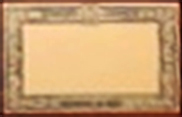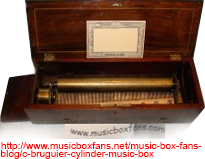|
Bruguier Geneva, Switzerland. The Bruguier family was famed as makers of mechanical singing birds and musical boxes. Extensive research by Pierre Germain reveals that Charles Abraham Bruguier (1788-1862) was the son of Jacques Francois Bruguier, a watchmaker of Saint-Gervais. A talented musical-box maker, he came to London in 1816 to live at 52, Great Marlborough Street; two years later he was living in Greek Street and it was here that his son, also Charles Abraham, was born in 1818 (he died in 1891). The father worked on musical boxes and automata in London, including a walking doll. About 1823 he returned to Geneva where he began making singing birds, improving on the mechanism brought to Geneva by Jaquet-Droz and Jean Frederick Leschot at the end of the eighteenth century. Germain deduces that between 1833 and 1837 Charles Abraham the father worked with Paur at Sainte-Suzanne, one piece of evidence being a small musical movement in the Blyelle-Horngacher collection signed in two places `Charles Bruguier à Mont Belliard´. By 1837, the Bruguiers were back in Geneva at rue du Cendrier 121 bis and the following year at rue de Coutance 75. Five years later, Charles Abraham junior married and in the 1843 census the two Charles Abrahams, father and son, are each listed as head of a workshop at two different addresses. Charles Abraham Senior´s daughter, Jacqueline, married in 1853 Jacques Bruguier (1801-73) who may have been a distant relative. The young Charles Abraham and his brother-in-law, Jacques, now continued the business. Jacques was a watchmaker and was also skilled in the making of mechanical birds. He and Jacqueline had a son in Geneva in 1855 – Jacques Alexandre Bruguier. Between 1870 and 1886 he, too, produced miniature singing birds at rue Bonivard 6, the premises of Baker-Troll. In 1855, he and his uncle, Charles Abraham the son, were the last singing-bird makers in Geneva. Soon afterwards, the history peters out. (Ord-Hume, Musical Boxes, p. 297) Bruguier, family of music box bakers (1815: London, 1823: Genf, 1833: Sainte-Suzanne, factory of Paur, 1837: Geneva) Charles-Abraham Bruguier sen., 1788–1862 Bruguier, Charles Abram, Geneva, born 1788, died 1862. Improved the mechanisms of mechanical, singing birds and produced them in large number. (Mosoriak p. 73) Charles-Abraham Bruguier jun., 1816–? Charles-Abraham Bruguier, the senior was born on January 5, 1788, in the family of a clockmaker and inherited the helm. In October 1813, he married Louise-Pernette Noiret, and in June 1814, their daughter Jacqueline was born. A year later, in June 1815 Charles-Abraham took his family to London, where they lived for several years. Other children were born there: Charles-Abraham in 1818 and Louise in 1821. The Bruguier family returned to Switzerland around 1823. It was apparently only after his return to Geneva that Charles-Abraham began creating singing birds. Between 1833 and 1837, Bruguier moved to the town of Sainte-Suzanne in France, to work in the Paur (later renamed as the L'epee) music-box factory. This fact explains the existence of music boxes with the Bruguier signature. In 1837, the Bruguier family returned to Geneva. After 1843, Bruguier acquired property in Gran-Pre (the north from Geneva), and transferred his workshop there. The last reference we have concerning Bruguier was his application for the passport in December 1861, for a scheduled trip to Paris. Six months later, in June 1862, he passed away at the age of 74. Charles Abraham Bruguier sen. is known for his unique bird boxes. Hence, he created other mechanical art items, quite unusual ones. As cited by his grandson “a clock surmounted by a vase, in the center of which a rose opens up every hour. A hummingbird appears from this rose. It sings and hides back, whereupon the rose closes up again”; “… a flute player is leaning against a tree. He plays and every movement of his fingers corresponds to a note. A small bird appears and sings; the man descends his flute and turns his head to listen. A cat suddenly appears and pounces on the bird just as it finishes its song, but the bird disappears and the man begins playing again”. Charles Abraham Bruguier sen. was 'the last of the great makers of singing birds in the true tradition of the Jaquet-Droz', to whom the invention of singing bird boxes has traditionally been attributed (Geoffrey T. Mayson, Mechanical Singing-Bird Tabatières, London, 2000, p. 16). Charles Abraham Bruguier jun. was born in 1816, and the family lived in London between 1816 and 1822, where Bruguier improved his craftmanship further on mechanical boxes of all sorts. His son continued his business later on, and much like Bontems, they did not only make these colourfully-enamelled cheerful bird boxes, but also specialised in repairing earlier examples of earlier automaton makers, such as Jaquet-Droz and Leschot. The Bruguier family [...] in Geneva [...] was famed as makers of mechanical singing birds and musical boxes. Extensive research by Pierre Germain reveals that Charles Abraham Bruguier (1788-1862) was the son of Jacques Francois Bruguier, a watchmaker of Saint-Gervais. A talented musical-box maker, he came to London in 1816 to live at 52, Great Marlborough Street; two years later he was living in Greek Street and it was here that his son, also Charles Abraham, was born in 1818 (he died in 1891). The father worked on musical boxes and automata in London, including a walking doll. About 1823 he returned to Geneva where he began making singing birds, improving on the mechanism brought to Geneva by Jaquet-Droz and Jean Frederick Leschot at the end of the eighteenth century. Germain deduces that between 1833 and 1837 Charles Abraham the father worked with Paur at Sainte-Suzanne, one piece of evidence being a small musical movement in the Blyelle-Horngacher collection signed in two places `Charles Bruguier à Mont Belliard´. By 1837, the Bruguiers were back in Geneva at rue du Cendrier 121 bis and the following year at rue de Coutance 75. Five years later, Charles Abraham junior married and in the 1843 census the two Charles Abrahams, father and son, are each listed as head of a workshop at two different addresses. Charles Abraham Senior´s daughter, Jacqueline, married in 1853 Jacques Bruguier (1801-73) who may have been a distant relative. The young Charles Abraham and his brother-in-law, Jacques, now continued the business. Jacques was a watchmaker and was also skilled in the making of mechanical birds. He and Jacqueline had a son in Geneva in 1855 – Jacques Alexandre Bruguier. Between 1870 and 1886 he, too, produced miniature singing birds at rue Bonivard 6, the premises of Baker-Troll. In 1855, he [Jacques Alexandre Bruguier] and his uncle, Charles Abraham the son, were the last singing-bird makers in Geneva. Soon afterwards, the history peters out. (Ord-Hume, Musical Boxes, p. 297) Sources: https://mus-col.com/en/the-authors/18140/; https://www.sothebys.com/en/buy/auction/2019/style-european-silver-gold-boxes-and-ceramics/a-silver-gilt-and-enamel-singing-bird-box-charles; Ord-Hume, Musical Boxes, p. 297
[1]
Auf diesem Bildzitat einer in Japan beheimateten Bruguier-Spieldose ist wenigstens zu erahnen, dass oben in der Mitte eine Lyra zu sehen ist, unten in Versalien ETOUFFIER EN ACIER [2] Silver Fusée Singing Bird Box by Charles Bruguier: He produced an average of only 27 of these precious boxes per year during his career (https://rauantiques.com/products/silver-fusee-singing-bird-box-by-charles-bruguier?variant=34858356572295) [3] A very early fine tortoiseshell, gold and enamel singing bird box, by Charles Bruguier (http://www.douglas-fisher.com/index.php?pg=stock&cat=antique_fusee_singing_bird_boxes&stock=425) [4] Vergldiche auch die Spieldosen mit einer Musiktafel des Designs „Aussen Perlenreihe, seitlich links und rechts Musikinstrumente“
|


